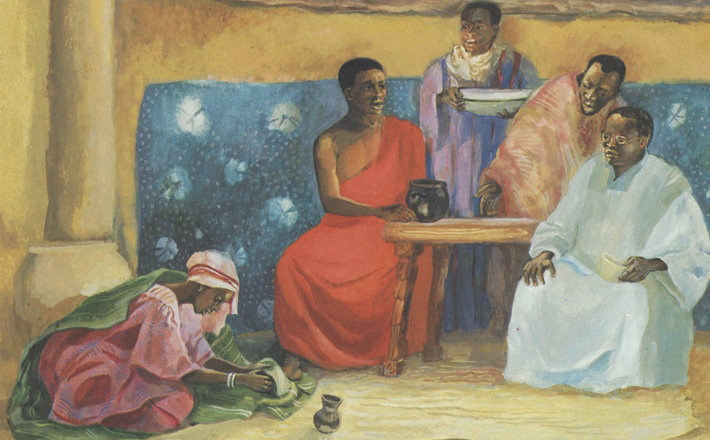Commentary on Luke 7:36-8:3
Imagine if you had invited guests to your home for dinner and suddenly someone entered your dining room uninvited and unexpected.
I know that I would not be very happy regardless of whom the person was. I think that we have to be a bit understanding of Simon and his shock as this woman enters and kneels at the feet of Jesus. My response would definitely be, “Who does she think that she is?”
We are asking the same question of Jesus, “Who does he think he is?” as we continue our journey with the author of Luke-Acts. Who is this Jesus of Nazareth? We have seen that he is a “long-distance” healer. And we have begun to wonder if Jesus is actually a prophet. Didn’t the crowd watch Jesus, like Elijah and Elisha, bring back to life the only son of a woman, a widow? The crowd declared that a great prophet had arisen, a great prophet who would do great things (Luke 7:16).
When following the Lectionary it is always important, not only to dig deeply into the text that is given, it is also important to investigate what have been skipped. Before today’s text we have learned that disciples of Jesus’ cousin John have been sent to ask him — are you the one? Jesus answers not with a simple yes or no, but by presenting them with the signs of the Messiah. Where people are being cured and the dead are raised, then you have been in the presence of the Messiah. These will definitely help us answer our question, “Who then is this?” (Luke 8:25).
There is another person who is wondering who is this Jesus of Nazareth. In today’s text we are told that a Pharisee named Simon decides to invite Jesus to his home for dinner. We don’t really know if he was a friend or a foe. We don’t know if Simon genuinely wanted to hear more of Jesus’ teaching, or if he really wanted to trick Jesus. What we do discover is that he was not a particularly good host, and he was hypercritical of Jesus.
In the previous healing and resuscitation stories the persons healed or returned to life had no prior contact with Jesus. And Jesus did not ask for any information about them. In this story the background of the person forgiven seems more significant. Again, we do not know if Jesus knew the woman who entered the home of Simon. But it would seem the Simon knew her, or better yet, knew of her reputation.
Let’s step back from this shocking scene for a moment to look briefly at the way this story appears in the other gospels. This is a story that appears in all four gospels but it appears in very different ways. In Mark and in Matthew’s gospel this episode takes place two days before the Passover. As they tell it, Jesus was in Bethany at the home of a different Simon, Simon the Leper. The unnamed woman pours nard, a burial ointment, over the head of Jesus, anticipating his burial. In this story it is not the host but the disciples who are angry with the woman because she has wasted the expensive ointment. We are told nothing of her character but Jesus praises her and reminds us that “where ever the good news is proclaimed … what she has done will be told in remembrance of her” (Mark 14:9). In John’s gospel the moment takes place six days before the Passover. It also takes place in Bethany, but it is in the home of Lazarus who was recently brought back from the grave. And now it is Lazarus’ sister Mary who anoints the feet of Jesus with the expensive nard and wipes his feet with her hair.
Simon and his guests are reclining at table, and perhaps dinner is in the process of being served when this woman, this sinner, enters the home of a Pharisee, uninvited. She pours oil over the feet of Jesus and unbinds her hair to wipe his feet now wet with the oil and her copious tears. She weeps and kisses the feet of Jesus. The woman does not give us any indication of why she is doing this. We should recognize that her action, whether or not she was a sinner, would have been scandalous. Aside from the fact that she crashed the party, a woman would never have uncovered her hair before strangers. Nor would she have touched a stranger’s feet. There are definitely sexual undertones in the picture painted by the author. Notice how, in Mark and Matthew’s gospels the oil is poured on Jesus’ head.
Who is at the center of this story? Is it the unnamed woman or the shocked Simon? We see a healing of sorts, the woman’s sins have been forgiven; she has been saved. Jesus does not speak with the woman. He asks her no questions. He asks nothing of her. But Jesus tells her that because of her scandalous actions which were truly acts of great love, her sins, “which were many, have been forgiven” (Luke 7:47).
Jesus would seem to want us to turn our attention to Simon. I suspect that Jesus always knew that he was always under intense scrutiny. Simon wants to know who Jesus is. The reason Simon does not think Jesus is a prophet is because he lets this sinner touch him. Simon does not understand the true nature of God’s love and acceptance. Simon would reject the woman and think that she was unworthy of God’s forgiveness.
Jesus is not only a healer; he is a mind reader as well. He can tell from the look on Simon’s face and read in the silence at the table that the Pharisee would dismiss the woman instead of forgiving her sins. So Jesus at the heart of this story is another story of two debtors. Simon recognizes that if a large debt is forgiven that debtor will love the one who forgives.
Jesus wants us to realize that we are all like the woman. She has come to Jesus with the large debt of sin. We are all like the woman and like the debtor who owes God an un-payable debt. Our healing comes when we, like the woman, kneel at Jesus’ feet and pour out our love.


June 12, 2016